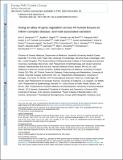| dc.contributor.author | Gamazon, Eric R. | |
| dc.contributor.author | Segrè, Ayellet V. | |
| dc.contributor.author | van de Bunt, Martijn | |
| dc.contributor.author | Wen, Xiaoquan | |
| dc.contributor.author | Xi, Hualin S. | |
| dc.contributor.author | Hormozdiari, Farhad | |
| dc.contributor.author | Ongen, Halit | |
| dc.contributor.author | Konkashbaev, Anuar | |
| dc.contributor.author | Derks, Eske M. | |
| dc.contributor.author | Aguet, François | |
| dc.contributor.author | Quan, Jie | |
| dc.contributor.author | GTEx Consortium | |
| dc.contributor.author | Nicolae, Dan L. | |
| dc.contributor.author | Eskin, Eleazar | |
| dc.contributor.author | Kamvysselis, Manolis | |
| dc.contributor.author | Getz, Gad | |
| dc.contributor.author | McCarthy, Mark I. | |
| dc.contributor.author | Dermitzakis, Emmanouil T. | |
| dc.contributor.author | Cox, Nancy J. | |
| dc.contributor.author | Ardlie, Kristin G. | |
| dc.date.accessioned | 2019-06-07T21:12:22Z | |
| dc.date.available | 2019-06-07T21:12:22Z | |
| dc.date.issued | 2018-06 | |
| dc.identifier.issn | 1061-4036 | |
| dc.identifier.issn | 1546-1718 | |
| dc.identifier.uri | https://hdl.handle.net/1721.1/121227 | |
| dc.description.abstract | We apply integrative approaches to expression quantitative loci (eQTLs) from 44 tissues from the Genotype-Tissue Expression project and genome-wide association study data. About 60% of known trait-associated loci are in linkage disequilibrium with a cis-eQTL, over half of which were not found in previous large-scale whole blood studies. Applying polygenic analyses to metabolic, cardiovascular, anthropometric, autoimmune, and neurodegenerative traits, we find that eQTLs are significantly enriched for trait associations in relevant pathogenic tissues and explain a substantial proportion of the heritability (40-80%). For most traits, tissue-shared eQTLs underlie a greater proportion of trait associations, although tissue-specific eQTLs have a greater contribution to some traits, such as blood pressure. By integrating information from biological pathways with eQTL target genes and applying a gene-based approach, we validate previously implicated causal genes and pathways, and propose new variant and gene associations for several complex traits, which we replicate in the UK BioBank and BioVU. | en_US |
| dc.description.sponsorship | National Institutes of Health (U.S.) (Contract HHSN268201000029C) | en_US |
| dc.language.iso | en | |
| dc.publisher | Springer Nature | en_US |
| dc.relation.isversionof | http://dx.doi.org/10.1038/S41588-018-0154-4 | en_US |
| dc.rights | Creative Commons Attribution-Noncommercial-Share Alike | en_US |
| dc.rights.uri | http://creativecommons.org/licenses/by-nc-sa/4.0/ | en_US |
| dc.source | PMC | en_US |
| dc.title | Using an atlas of gene regulation across 44 human tissues to inform complex disease- and trait-associated variation | en_US |
| dc.type | Article | en_US |
| dc.identifier.citation | Gamazon, Eric R. "Using an atlas of gene regulation across 44 human tissues to inform complex disease- and trait-associated variation." Nature Genetics 50, 7 (July 2018): 956–967 © 2018 The Author(s) | en_US |
| dc.contributor.department | Massachusetts Institute of Technology. Computer Science and Artificial Intelligence Laboratory | en_US |
| dc.relation.journal | Nature Genetics | en_US |
| dc.eprint.version | Author's final manuscript | en_US |
| dc.type.uri | http://purl.org/eprint/type/JournalArticle | en_US |
| eprint.status | http://purl.org/eprint/status/PeerReviewed | en_US |
| dc.date.updated | 2019-06-07T15:07:35Z | |
| dspace.date.submission | 2019-06-07T15:07:38Z | |
| mit.journal.volume | 50 | en_US |
| mit.journal.issue | 7 | en_US |
